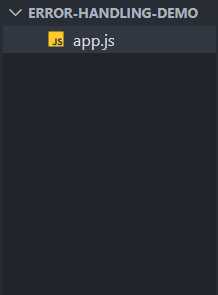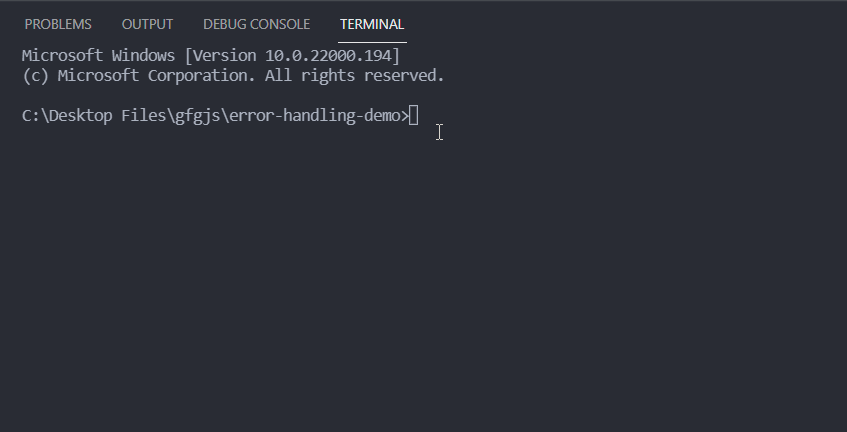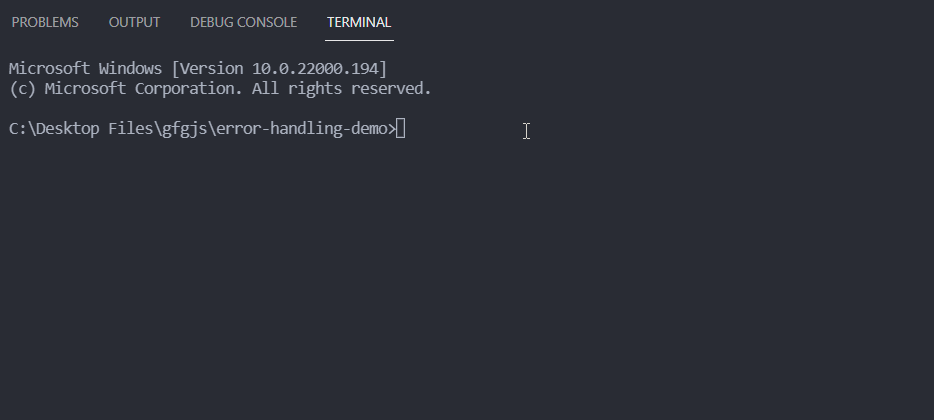Node.js 如何处理异步代码错误
JavaScript中的异步操作是指不会阻塞其他操作的操作。这意味着,如果我们在代码的某一点执行异步操作,则在此之后的代码会被执行,而不会等待异步操作完成。Node.js中的一个异步操作示例是当我们从Web服务器请求一些数据时。
如果我们想要处理Node.js中的异步代码错误,则可以按照以下两种方式进行。
- 使用回调函数处理错误
- 处理Promise拒绝
使用回调函数处理错误: 回调函数是在函数执行完成后执行某些操作的函数。我们可以在异步操作完成后调用回调函数。如果有错误,我们可以调用带有该错误的回调函数,否则我们可以调用它并将错误设置为null以及异步操作的结果作为参数。
项目设置:
步骤1: 安装Node.js(如果尚未安装)。
步骤2: 为您的项目创建一个文件夹,并在其中切换到该文件夹。在该文件夹中创建一个名为app.js的新文件。
项目结构: 按照上述步骤完成后,您的项目结构将如下所示。

在下面的代码示例中,我们使用setTimeout()方法模拟了一个异步操作。我们执行一个除法操作,1秒后返回除法的结果,如果除数为零,我们会将一个错误实例传递给回调方法。如果没有错误,我们将调用回调函数,并将错误设置为null,将除法的结果作为参数传递。错误和结果在我们的回调函数中进行处理。
app.js
const divide = (a, b, callback) => {
setTimeout(() => {
if (b == 0) {
callback(new Error('Division by zero error'));
} else {
callback(null, a / b);
}
}, 1000);
};
divide(10, 2, (err, res) => {
if (err) {
console.log(err.message);
} else {
console.log(`The result of division = {res}`);
}
});
divide(5, 0, (err, res) => {
if (err) {
console.log(err.message);
} else {
console.log(`The result of division ={res}`);
}
});
运行应用程序的步骤: 您可以在命令行上使用以下命令来执行您的 app.js 文件。
node app.js
输出:

处理 Promise rejection(拒绝): 在 Node.js 中,Promise 是处理异步操作的一种方式。我们可以从异步函数中返回一个 Promise,并使用 then() 方法或 async/await 来获取最后的值。当我们使用 then() 方法来消费 Promise 时,如果需要处理 Promise 的拒绝,我们可以在 then() 方法调用中添加 catch() 方法调用。Promise.catch() 是一个返回 Promise 的方法,其工作是处理被拒绝的 Promise。
语法:
// func is an async function
func().then(res => {
// code logic
}).catch(err => {
// promise rejection handling logic
})
现在,如果我们想使用async/await处理Promise的拒绝,我们可以简单地使用下面给出的语法中的try/catch块来实现。
const hello = async () => {
try {
// func is an async function
const res = await func();
} catch(err) {
// error handling logic
}
}
在下面的示例中,我们使用setTimeout()方法模拟一个异步函数,并在一个返回Promise的异步函数中执行除法操作。如果除数为零,我们会拒绝Promise并返回一个错误,否则我们会使用除法结果解析Promise。
app.js
const divide = async (a, b) => {
return new Promise((resolve, reject) => {
setTimeout(() => {
if (b == 0) {
reject(new Error('Division by zero error'));
} else {
resolve(a / b);
}
}, 1000);
});
};
// Consuming the promise using then() method
// and handling the rejected promise using
// catch() method
divide(5, 0)
.then((res) => {
console.log(`The result of division is {res}`);
})
.catch((err) => {
console.log(err.message);
});
// This function is immedietly invoked after
// its execution. In this case we consume the
// promise returned by divide function() using
// async/await and handle the error using
// try/catch block
(async () => {
try {
const res = await divide(10, 5);
console.log(`The result of division is{res}`);
} catch (err) {
console.log(err);
}
})();
输出:

 极客教程
极客教程